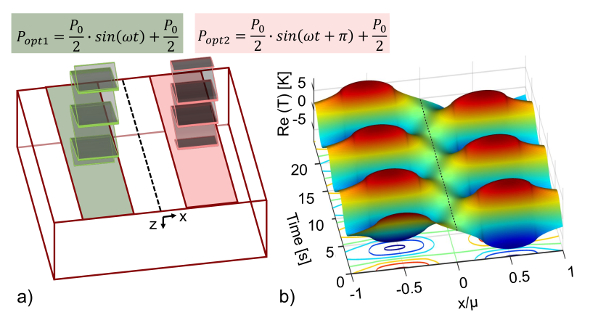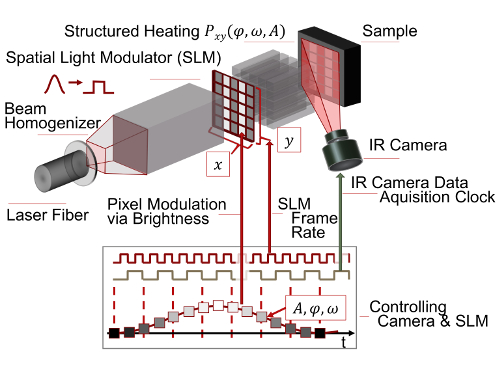使用激光投射光热法构造加热的地下缺陷定位
Summary
该方法旨在定位垂直的地下缺陷。在这里,我们将激光与空间光调制器耦合,并触发其视频输入,以确定性地用两个反相调制线加热样品表面,同时获得高分辨率的热图像。从评估热波干扰最小值来检索缺陷位置。
Abstract
所提出的方法用于定位垂直于表面定向的地下缺陷。为了实现这一点,我们创造了被缺陷所扰乱的破坏性的干扰热波场。测量这种效应并用于定位缺陷。我们通过使用改进的投影仪形成破坏性干扰波场。投影机的原始光引擎被替换为光纤耦合的大功率二极管激光器。其光束被成形并对齐于投影仪的空间光调制器,并通过首先表征光束轮廓而优化用于最佳光学吞吐量和均匀投影,以及第二,其机械和数字校正。根据紧凑的几何情况(包括几何图像失真的校正)和检测样品表面的弱温度振荡的要求,建立了高性能红外(IR)摄像机。数据采集可以执行一次同步通过使用专门的实验装置来建立各个热波场源,扫描阶段和红外相机之间的谐波,这需要调整到被调查的具体材料。在数据后处理期间,提取关于在样品表面下存在缺陷的相关信息。从获取的来自样品表面的所谓耗尽线的热辐射的振荡部分中取出。在最终步骤中,从这些振荡的空间 – 时间形状的分析中推导出缺陷的确切位置。该方法无参考,对热波场内的变化非常敏感。迄今为止,该方法已经用钢样品进行了测试,但也适用于不同的材料,特别是温度敏感材料。
Introduction
激光投射光热法(LPPT)方法用于定位埋在试样体积中并且主要垂直于其表面定向的地下缺陷。
该方法使用了相同延伸率和频率的两个反相热波场的破坏性干扰, 如图1b所示 。在各向同性无缺陷材料中,热波通过相干叠加在对称平面上中和破坏性( 即零温度振荡)。在具有地下缺陷的材料的情况下,该方法利用瞬态热流与该缺陷之间的横向( 即面内)分量的相互作用。这种相互作用可以在样品表面上的对称线上以重现的振荡温度伸长率来测量。现在,通过叠加的热波场扫描含有缺陷的样品相对于样品位置测量温度伸长的水平。由于对称性,当缺陷穿过对称平面时,再次满足破坏性干扰条件;这使我们能够非常敏感地定位缺陷。此外,由于破坏性干扰的最大扰动水平与缺陷的深度相关,因此可以通过分析温度扫描1来确定其深度。
LPPT可以分配到有源热成像方法,一种已建立的非破坏性方法,其中主动产生瞬态加热,并且通过热红外相机测量所得到的瞬态温度分布。通常,该方法的灵敏度限于基本上垂直于瞬态热流定向的缺陷。此外,由于控制瞬态热传导方程是抛物线部分不同的中性方程式,进入体积的热流强烈衰减。因此,有源热成像方法的探测深度被限制在近表面区域,通常在毫米范围内。两种最常见的有源热成像技术是脉冲和锁定热成像技术。它们由于平面光学表面照明2而快速,但是导致垂直于表面的瞬时热流。因此,这些技术的灵敏度仅限于主要与加热的样品表面平行( 例如脱层或空隙)取向的缺陷。脉冲热成像的经验规则表明,“最小可检测缺陷的半径应该比其在表面下方的深度大至少1到2倍” 3 。为了增加垂直取向的缺陷( 如裂纹)与热流之间的有效相互作用面积,热流的方向需要改变。例如,通过使用具有线性或圆形斑点的聚焦激光器的局部激发产生具有能够有效地与垂直缺陷4,5,6,7相互作用的面内部件的热流。
在所提出的方法中,我们还使用横向热流分量来检测地下缺陷,但是我们使用热浪可以叠加的事实,而缺陷,特别是垂直取向的,可以扰乱这种叠加。以这种方式,所提出的方法类似于无参考,对称和非常敏感的方法,因为可以在远低于8,9的宽/深比下检测人造地下缺陷。到目前为止,很难建立两个提供足够能量的反相热波场。我们实现了这个b将空间光调制器(SLM)耦合到大功率二极管激光器,这使得我们能够将激光系统的高光功率与SLM的空间和时间分辨率( 见图2 )合并成大功率投影仪。热波场现在通过经投影图像的像素亮度的两个反相正弦调制线图案的光热转换来产生( 见图2 , 图1a )。这导致样品表面的结构化加热并导致明确的破坏性干扰热波场。为了找到地下缺陷,使用红外相机测量破坏推理的干扰作为表面的温度振荡。
术语热波是有争议的,因为热波不能由于热传播的扩散特性而传输能量。不过,当hea有波浪般的行为定期使用,使我们能够在实际波和扩散过程10,11,12之间使用相似之处。因此,热波可以被理解为在传播方向上高度衰减但是随时间周期性( 图1b )。特征热扩散长度 通过其材料特性(热导率k ,热容c p和密度ρ )以及激发频率ƒ来描述。尽管热波强烈衰减,但它的波浪性质可以应用于获得样品性质的洞察力。首先应用热波干涉来确定层的厚度。与我们的方法相比,干涉效应用于深度尺寸( 即垂直于表面)参考“13。通过分割激光束将干扰思想扩展到第二维度,使用热波干涉来对地下缺陷进行调整14 ,仍然以传输方式应用该方法,这意味着它受到渗透的限制此外,由于仅使用一个激光源,该方法施加了建设性的干扰,这意味着无需参考,除了使用热波干扰的想法外,第一种技术方法是空间和Holtmann 等人使用具有内置光源的未经修改的液晶显示器(LCD)投影仪进行时间控制的加热,其光输出功率受到严格限制15.Pribe和Ravichandran的进一步接近旨在增加光学通过将激光器耦合到SLM 16来输出功率, s =“xref”> 17。
通过其材料特性(热导率k ,热容c p和密度ρ )以及激发频率ƒ来描述。尽管热波强烈衰减,但它的波浪性质可以应用于获得样品性质的洞察力。首先应用热波干涉来确定层的厚度。与我们的方法相比,干涉效应用于深度尺寸( 即垂直于表面)参考“13。通过分割激光束将干扰思想扩展到第二维度,使用热波干涉来对地下缺陷进行调整14 ,仍然以传输方式应用该方法,这意味着它受到渗透的限制此外,由于仅使用一个激光源,该方法施加了建设性的干扰,这意味着无需参考,除了使用热波干扰的想法外,第一种技术方法是空间和Holtmann 等人使用具有内置光源的未经修改的液晶显示器(LCD)投影仪进行时间控制的加热,其光输出功率受到严格限制15.Pribe和Ravichandran的进一步接近旨在增加光学通过将激光器耦合到SLM 16来输出功率, s =“xref”> 17。
本文介绍的方案描述了如何应用LPPT方法来定位垂直于钢样品表面定向的地下缺陷。该方法处于早期阶段,但足够强大以验证拟议的方法;然而,在实验装置的可实现的光输出功率方面仍然受到限制。由于光输出功率的增加仍然是一个挑战,所提出的方法适用于含有人造放电加工缺口的涂层钢。然而,协议的最重要和最关键的步骤,产生均匀的结构化照明,满足破坏性热波干扰的先决条件,以及定位缺陷,仍然适用于更严格的缺陷。由于控制量是热扩散长度μ,LPPT方法也可应用于许多不同的材料。
NT“>
图1:破坏性干扰效应原理。 ( a )实验中使用的照明图案的示意图。样品在空间和时间上加热了相位移π的两个周期性照明图案。虚线表示两个图案之间的对称线。这条线将用作“耗尽线”的评估。 ( b )从热传导方程的分析解算出的空间和时间分辨的交替热结果图。它显示了对于(a)具有P opt 1 = 1.5W sin(2π0.125Hz t )+ 1.5W和P opt 2 = 1.5W sin(2π0.125Hz t )的两种图案的照度的响应热波+π)+ 1.5 W用于结构钢ρ </em = 7,850kg / m 3 , c p = 461J /(kg·K), k = 54W /(m·K)。虚线处的温度曲线显示均匀的各向同性材料的热振荡。 请点击此处查看此图的较大版本。

图2:主动热成像中使用的结构化加热的测量原理示意图。将均匀化为顶帽型材的高斯光束施加到空间光调制器(SLM)。 SLM通过其可切换元件在空间上解决光束,并通过其切换速度暂时解决光束。每个元素表示SLM像素。在本实验中,SLM是数字微镜装置(DMD)。通过用时间确定性控制软件调制像素亮度A ,样品表面以结构化的方式加热。在所提出的实验的情况下,我们调制两个反相线(相位:φ= 0,π),它们是角频率ω处的相干干扰热波场的起源。波场与样品的内部结构相互作用,也影响表面的温度场。这是通过中波红外摄像机的热辐射来测量的。 请点击此处查看此图的较大版本。
Protocol
Representative Results
Discussion
所提出的协议描述了如何定位垂直于表面定向的人造地下缺陷。该方法的主要思想是产生与地下缺陷相互作用的干扰热波场。最重要的步骤是(i)将SLM与二极管激光器组合,以便在样品表面产生两个交替的高功率照明图案;这些图案被光热转换成相干热波场,(ii)让它们在与地下缺陷相互作用的同时被破坏性地干扰,以及(iii)使用热成像从样品表面的动态温度的表面扫描中定位这些缺陷红外摄…
Disclosures
The authors have nothing to disclose.
Acknowledgements
我们要感谢Taarna Studemund和Hagen Wendler拍摄实验设备的照片,并为他们的图形出版做准备。此外,我们要感谢Anne Hildebrandt的样品准备工作,Sreedhar Unnikrishnakurup,Alexander Battig和Felix Fritzsche进行验证。
Materials
| 500 W diode laser system, 940 nm | Laserline | LDM 500 – 20 | Pilot laser class 2 @ 650 nm, diode laser is a class 4 laser system –> special laboratory needed |
| Laser control box | Laserline | Laser control box LDM | Add on to the laser system, used to switch electronically, laser threshold, shutter, laser on 0 V ..5 V TTL |
| Control box scanner | Laserline | Add on to the laser system, used to adjust the optical output power via analog signal from 0 V..10 V | |
| Fiber Laser Mount 2", f = 80 mm | Laserline | Add on to the laser system | |
| Multifunction Data Aquisition (DAQ) Device + BNC Terminal | National Instruments | NI-USB 6251 | The DAQ card is used to trigger the IR camera, the DLP Light Commander 5500, control Laser and diode PDA 36A |
| Standard – PC | Control PC – graphic card for two screens, at least 4 x USB, Windows based | ||
| BNC cabel | Standard cable | ||
| HDMI cable | Standard cable | ||
| Micro USB to USB cable | Standard cable | ||
| LabVIEW 2013 SP1 Development System | National Instruments | Development environment for device control | |
| LPPT control software | BAM | part of the LPPT software package by LabVIEW 2013 SP1 | |
| LPPT intensity software | BAM | part of the LPPT software package by LabVIEW 2013 SP1 | |
| LPPT laser control software | BAM | part of the LPPT software package by LabVIEW 2013 SP1 | |
| Matlab 2016b | MathWorks | Postprocessing of the measurement data | |
| LPPT postprocessing software | BAM | Postprocessing of the measurement data | |
| IR camera control PC | InfraTec | Control PC is supplied by camera distributor | |
| IR camera control software | InfraTec | Irbis 3 Professional | |
| InfraTec SDK | InfraTec | Dynamic Link Library as interface between the native data aquisition format of Infratec and Matlab | |
| IR camera | InfraTec | Image IR 8300 | 640 x 512, cooled InSb detector, wavelength 2 µm..5.7 µm, noise = 20 mK + accessories (LAN cable, Digital in/out cable, space ring, power supply, case) |
| Tripod | Manfrotto | 161MK2B | |
| IR camera mount | Manfrotto | 405 | |
| Projector development kit (PDK) for digital light processing (DLP) technology (DLP Light Commander 5500) | Logic PD | DLP-LC-DLP5500-10R | DLP5500 Digital Micromirror Device from Texas Instruments included , light engine and case need to be disassembed |
| PDK control software | Logic PD | Included when delivered, DLP Light Commander control software | |
| Mechanical platform for the PDK | BAM | Self made (140 x 230 x 420) mm | |
| Power meter control unit | Ophir | Vega | USB Interface |
| 30 W power meter head | Ophir | 30(150)A-LP1-18 | Power meter head to determine Transmission of the projector system |
| 500 W power meter head | Ophir | FL500A | Power meter for process supervision |
| Motion controller | Newport | ESP301 | with USB Interface |
| Translation stage | Newport | M-ILS200CC | Connected to ESP301 |
| Photodiode with amplifier | Thorlabs | PDA 36A-EC | 1" mount |
| Reflective filter ND1 | Thorlabs | ND10A | to be mounted to the PDA 36A |
| Pinhole 1" | Thorlabs | P1000S | to be mounted to the PDA 36A |
| Optical aluminium breadboard | Thorlabs | MB60120/M | (1200 mm x 900 mm) base |
| Plano Convex Lens f = 200 mm | Thorlabs | LA1979-B | Coated for IR, first telescope lens |
| Plano Convex Lens f = 75 mm | Thorlabs | LA1145-B | Coated for IR, second telescope lens |
| xy-translation stage | Newport | M401 | Used for adjusting the telecope |
| Beamsampler | Thorlabs | BSF20-B | Splits the optical output, used to reduce the optical input for the projector system |
| Mirror | Thorlabs | BB2-E03 | Mirror for coupling the beam to the DLP Light Commander |
| Heavy duty lab jack | Thorlabs | L490 | Used for the fiber mount and on top of the linear stage to position the sample (2x) |
| PDK-objective | Nikon | Nikon AF Nikkor 50 mm 1:1:8:D | Objective for DLP Light Commander, 50 mm |
| Plano Convex Lens f = 100 mm | Thorlabs | LA1050 -B | Lens is attached to the Nikon Objective |
| Bi-Convex Lens f = 60 mm | Thorlabs | LB1723 -B | Lens to be attached to the Nikon objective in order to determine the optical transmission with the 30 W measurement head |
| Square protected gold mirror | Thorlabs | PFSQ20-03-M01 | |
| High power IR sensor card | Newport | F-IRC-HP-M | Sensor card to check the optical pathway |
| 2" crosshairs | BAM | Selfmade | |
| 1" crosshairs | BAM | Selfmade | |
| Bullseye level | Thorlabs | LCL01 | |
| Translation Stage | Newport | M-UMR8.25 | Used for measuring the beam profile |
| Micrometer screw | Newport | DM17-25 | Used with translation stage M-UMR8.25 |
| Mounted Zero Aperture Iris | Thorlabs | ID75Z/M | used to check the optical pathway |
| Bases and Post Holders Essentials Kit, Metric and Universal Components | Thorlabs | ESK01/M | Basis |
| Posts & Accessories Essentials Kit, Metric and Universal Components | Thorlabs | ESK03/M | |
| M6 Cap Screw and Hardware Kit | Thorlabs | HW-KIT2/M | |
| Construction Rails | Thorlabs | XE25L700/M | |
| 1" Construction Cube | Thorlabs | RM1G | Used to mount construction rails |
| Electrical discharge machining | Sodick | AG60L | www.sodick.de |
| St37 block of steel (100 x 100 x 40) mm | BAM | selfmade, hidden defect with remaining wall thicknesses of 0.25 mm, 0.5 mm, 0.70 mm 1.25 mm (shown in Fig. 5) | |
| St37 block of steel (100 x 100 x 40) mm | BAM | selfmade, hidden defect with remaining wall thicknesses of 1 mm, 1.5 mm, 1.75 mm, 2 mm (shown in Fig. 5) | |
| Graphite spray | CRC Industries Europe NV | GRAPHIT 33 | Ref. 20760, 200 ml aerosol (Kontakt-Chemie) |
| Protective tape | Tesa | tesakrepp 4348 | used to protect the hidden defects while coating |
References
- Thiel, E., Kreutzbruck, M., Ziegler, M. Laser-projected photothermal thermography using thermal wave field interference for subsurface defect characterization. Appl. Phys. Lett. 109 (12), 123504 (2016).
- Ibarra-Castanedo, C., Tarpani, J. R., Maldague, X. P. V. Nondestructive testing with thermography. Eur. J. Phys. 34 (6), 91-109 (2013).
- Maldague, X. P. Introduction to NDT by active infrared thermography. Mater. Eval. 60 (9), 1060-1073 (2002).
- Li, T., Almond, D. P., Rees, D. A. S. Crack imaging by scanning pulsed laser spot thermography. Ndt&E Int. 44 (2), 216-225 (2011).
- Lugin, S. Detection of hidden defects by lateral thermal flows. Ndt&E Int. 56, 48-55 (2013).
- Li, T., Almond, D. P., Rees, D. A. S. Crack imaging by scanning laser-line thermography and laser-spot thermography. Meas. Sci. Technol. 22 (3), (2011).
- Pech-May, N. W., Oleaga, A., Mendioroz, A., Salazar, A. Fast Characterization of the Width of Vertical Cracks Using Pulsed Laser Spot Infrared Thermography. Journal of Nondestructive Evaluation. 35 (2), 22 (2016).
- Thiel, E., Kreutzbruck, M., Ziegler, M., Douglass, M. R., King, P. S., Lee, B. L. . Proc. SPIE 9761. , (2016).
- Thiel, E., Kreutzbruck, M., Ziegler, M. . Proc. WCNDT 2016. , 6 (2016).
- Mandelis, A. . Diffusion-Wave Fields: mathematical methods and Green functions. , (2001).
- Almond, D., Patel, P. . Photothermal Science and Techniques. 10, (1996).
- Salazar, A. Energy propagation of thermal waves. Eur. J. Phys. 27 (6), 1349-1355 (2006).
- Bennett, C. A., Patty, R. R. Thermal wave interferometry: a potential application of the photoacoustic effect. Appl. Opt. 21 (1), 49-54 (1982).
- Busse, G. Stereoscopic depth analysis by thermal wave transmission for nondestructive evaluation. Appl. Phys. Lett. 42 (4), 366 (1983).
- Holtmann, N., Artzt, K., Gleiter, A., Strunk, H. P., Busse, G. Iterative improvement of Lockin-thermography results by temporal and spatial adaption of optical excitation. Qirt J. 9 (2), 167-176 (2012).
- Pribe, J. D., Thandu, S. C., Yin, Z., Kinzel, E. C. Toward DMD illuminated spatial-temporal modulated thermography. Proc. SPIE 9861. , (2016).
- Ravichandran, A. . Spatial and temporal modulation of heat source using light modulator for advanced thermography. , (2015).
- . . DLP 0.55 XGA Series 450 DMD. , (2015).
- . DLP LightCommander Control Software – User Manual Available from: https://support.logicpd.com/ProductDownloads/LegacyProducts/DLPLightCommander.aspx?_sw_csrfToken=318b0448 (2011)
- Moench, H., et al. High-power VCSEL systems and applications. Proc. SPIE 9348. , (2015).

